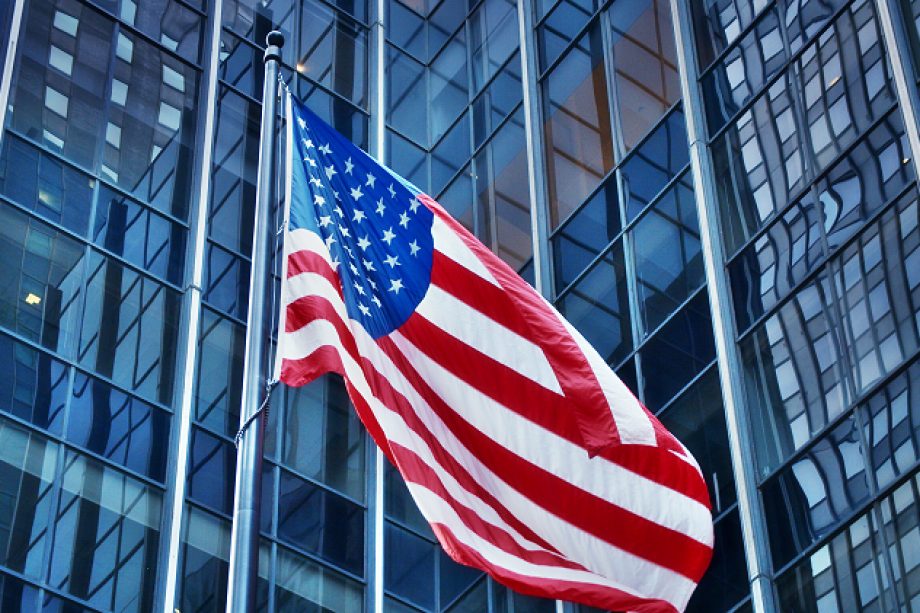Economy & Markets
1 minute read
What you need to know about the trade war rollercoaster


A vocal contingent on Wall Street believes it is time to “Sell America.” They argue that the actions of the current U.S. administration—chaotic tariff policy, an aggressive anti-immigration stance, threats to the independence of the Federal Reserve (Fed), challenges to the rule of law and a “war on science” to name a few—signal the beginning of the end of “U.S. exceptionalism.” (We’ll define the widely used term as U.S. economic and market leadership.)
The prospect of a significantly higher debt and deficit, the “Sell America” crowd believes, adds to a sense of urgency.
Count us in the “Buy America” camp.
The United States has drawn on a rare alignment of institutional, cultural, legal and technological systems that have protected and propelled shareholder returns for the better part of a century. Deep, liquid capital markets, transparency, respect for the rule of law—these are among the pillars of U.S. exceptionalism that made and have kept the U.S. dollar a global reserve currency, the Treasury market the arbiter of the “risk-free” rate and the stock market the most consistent performer in the world. Some believe these pillars have already begun to erode, but history shows us that past challenges have ultimately renewed U.S. strength. The current episode, in our view, will likely be no different.
Here, we consider the historical context for the “Sell America” debate, examine past parallels with the current landscape and offer what we hope will be a useful perspective for investment decision making. Through a shareholder lens, we focus in particular on the Fed, the courts and culture.
As President Donald Trump has called on Fed Chair Jerome Powell to lower interest rates, investors are reminded of the importance of central bank independence. Attacks on the Fed’s autonomy could destabilize markets.
Of course, Trump is not the first president to pressure a Fed chair, and the history of America’s central bank includes many episodes of challenge and crisis. Along the way, the Fed evolved into a more autonomous and effective institution.
In a sense, Andrew Jackson laid the groundwork for the modern Fed when he removed the charter of the Second Bank of the United States in 1833. The decision contributed to the boom-and-bust cycles of the 19th century economy and revealed the costs of weakness at a critical U.S. institution. In 1913, an act of Congress established the Fed to protect the banking system.
Two noteworthy cases of executives encroaching on Fed independence: During the Great Depression, Franklin D. Roosevelt picked Marriner Eccles to be Fed Chair in part because he was willing to pursue FDR’s preferred strategy of debt-financed stimulus, and encouraged the Banking Act of 1935, which centralized the Fed’s power in Washington. In the runup to the 1972 election, President Richard Nixon famously berated Fed Chair Arthur Burns for keeping monetary policy too tight. (Burns did subsequently lower rates, which led to a long period of stagflation.)
What should we make of the more recent chapter in Fed history, when the central bank effectively reinvented monetary policy amid the 2008 global financial crisis (GFC)?
Economic historians will debate the pros and cons of the unprecedented monetary policy tools (including quantitative easing and a zero interest rate policy) the Fed adopted post-GFC. In our view, the Fed’s actions to aggressively expand its role as lender of last resort protected the economy, banking system and the financial markets on which shareholders depend. During COVID, the Fed staunched a violent equity and credit market sell-off by committing to purchase corporate bonds. Indeed, the central bank was able to act independently despite vocal meddling from then President Trump.
For more than a century, the U.S. judicial system has served as a reliable protector of shareholder rights. The story begins in the early 1800s when Supreme Court decisions (notably Dartmouth v. Woodward in 1819) established the sanctity of contracts. In 1899, Delaware enacted its General Corporation Law, and established that directors owe fiduciary duties of care and loyalty to shareholders, not stakeholders.
Today, over 60% of Fortune 500 companies are registered in the state.
A key decision affirming shareholder rights arrived in 1952, when the Supreme Court struck down President Harry Truman’s attempt to seize steel mills during a labor dispute. The court’s decision found that private property and corporate control are not subject to executive fiat.
Most recently, the federal courts are reviewing various actions by the Trump administration, including its announced reciprocal tariffs and government funding cuts, as potentially illegal or unconstitutional exercises of executive authority. Indeed, the current Supreme Court has also hinted strongly that it doesn’t believe the President has the authority to terminate Fed governors without cause.
Whatever the outcomes of any specific cases, we expect the courts will likely continue to act as a powerful protector of corporate legitimacy.
In many ways, American culture celebrates entrepreneurship and innovation. Business titans and entertainment tycoons such as Andrew Carnegie, Henry Ford, Oprah Winfrey and Steve Jobs have captured the public imagination. Failure is reframed as resilience. What is the American Dream? It’s a self-made millionaire.
That dream has seemed more elusive in recent decades. Worsening income inequality—and capital’s rising share of GDP relative to labor’s—have stoked popular discontent. In many other countries, populist anger has triggered the nationalizing of industries, even revolutions.
 What is the American Dream? It’s a self-made millionaire.
What is the American Dream? It’s a self-made millionaire.
But the United States has often deflected popular anger through reforms that strengthened the system. Teddy Roosevelt’s trust-busting campaign called for a “square deal” characterized by market fairness enforced by law. After the Enron scandal in 2001, the Sarbanes-Oxley Act improved corporate transparency. Recent antitrust cases from both the Biden and Trump administrations have not hindered market returns from the stock market at large. We note, too, that curtailing the power of mega-cap companies can incentivize competition from the startup ecosystem.
In today’s American culture, Silicon Valley stands out as a singular totem of innovation, ambition and wealth creation. It draws on a long history of U.S. technological progress made possible by deep capital markets and a cultural belief in capitalism’s promise. One proof point: By any measure, the exceptionally profitable U.S. technology sector ranks as a global market leader.
Among past episodes of technological innovation facilitated by capital markets: Securities syndication and corporate dividend payment evolved to develop railroad construction in the 1800s. Municipal and corporate bond sales financed centralized power stations and transmission lines in the early 1900s. After World War II, Wall Street provided the capital necessary to scale civilian aviation. Private capital financed the telephone, which paved the way for integrated circuits, personal computers, the internet and artificial intelligence (AI).
That U.S. innovation ecosystem may now be under threat, say those who worry about eroding U.S. exceptionalism. They point to the current administration’s hostile rhetoric toward science (e.g., climate change, vaccine research and public health officials), its dramatic cuts to National Institute of Health (NIH) grants and budgets, and its treatment of elite universities and non-U.S. students and immigrants.
Certainly, research from the U.S. government’s Defense Advanced Research Agency (DARPA), the NIH and elite universities have contributed to technological innovation and commercialization at scale. But the historical evidence suggests that American innovation is decentralized and resilient to political cycles. The semiconductor industry relied on the military and NASA in its infancy, and Stanford University helped incubate many breakthroughs, but private capital effectively financed the post-WWII waves of innovation.
Other countries innovate. But in our view, only the United States sustains a system in which institutions, culture and capital markets symbiotically scale innovation across sectors and decades. Japan and Germany both boast world-class engineering, yet cultural conservatism and shallow venture capital ecosystems have limited investor returns.
Chinese policymakers generate rapid industrial and technological advancements, but political interference stifles private enterprises and redirects outcomes for strategic, not shareholder, benefit. Many emerging market economies have oscillated between periods of oligarchy and populism, undermining market credibility and reinvestment.
How secure is U.S. exceptionalism? As we’ve discussed, some observers identify threats to U.S. exceptionalism in what they see as the emergence of crony capitalism, corruption and the abuse of government power. The rule of law, they argue, seems newly vulnerable. In this context, government actions against major law firms and elite universities, mostly notably Harvard, are at the center of the debate.
Despite periods of executive encroachment on the independence of key institutions of the government and civil society, populist backlash against market-based capitalism, and crises of confidence in American geopolitical leadership, we believe the United States remains uniquely structured to align risk capital with institutional legitimacy, cultural cachet and innovation. Throughout these cycles, the system has evolved in a way that prioritizes asset holders.
What does this mean for your portfolio? Certainly, it makes sense to reassess global asset allocation, diversifying securities and currency exposures. The dollar in particular may be on the precipice of a cyclical, if not secular, decline as investor perceptions of U.S. exceptionalism shift.
But we do feel confident that U.S. risk assets will continue to command a premium valuation. The U.S. dollar will maintain its role as the global reserve currency. The U.S. innovation economy can continue to outperform. All of these factors enable the government to borrow at interest rates below the rate of potential growth, limiting the risk of a fiscal crisis despite ever increasing debt loads.
In short: Don’t ignore global opportunities, but be very wary of selling America.
We can help you navigate a complex financial landscape. Reach out today to learn how.
Contact usLEARN MORE About Our Firm and Investment Professionals Through FINRA BrokerCheck
To learn more about J.P. Morgan’s investment business, including our accounts, products and services, as well as our relationship with you, please review our J.P. Morgan Securities LLC Form CRS and Guide to Investment Services and Brokerage Products.
JPMorgan Chase Bank, N.A. and its affiliates (collectively "JPMCB") offer investment products, which may include bank-managed accounts and custody, as part of its trust and fiduciary services. Other investment products and services, such as brokerage and advisory accounts, are offered through J.P. Morgan Securities LLC ("JPMS"), a member of FINRA and SIPC. Insurance products are made available through Chase Insurance Agency, Inc. (CIA), a licensed insurance agency, doing business as Chase Insurance Agency Services, Inc. in Florida. JPMCB, JPMS and CIA are affiliated companies under the common control of JPMorgan Chase & Co. Products not available in all states.
Please read the Legal Disclaimer for J.P. Morgan Private Bank regional affiliates and other important information in conjunction with these pages.
Bank deposit products, such as checking, savings and bank lending and related services are offered by JPMorgan Chase Bank, N.A. Member FDIC.
Not a commitment to lend. All extensions of credit are subject to credit approval.
